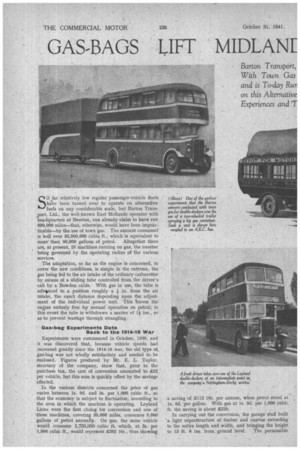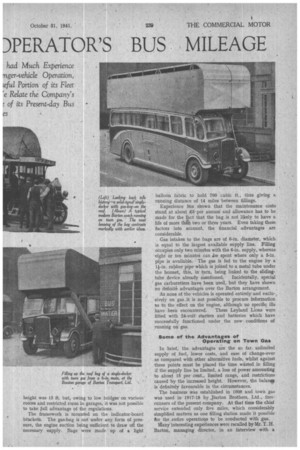GAS-BAGS LIFT MIDLANI DPERATOR'S BUS MILEAGE
Page 26

Page 27

Page 28

If you've noticed an error in this article please click here to report it so we can fix it.
Barton Transport, With Town Gas and is To-day Rut] on this Alternative Experiences and T
had Much Experience nger-vehicle Operation, ;eful Portion of its Fleet re Relate the Company's of its Present-day Bus es
SO far relatively few regular passenger-vehicle fleets hiwve been turned over to operate on alternative fuels on any considerable scale, but Barton Trans,port, Ltd., the well-known East Midlands operator with headquarters at Beeston, can already claim to have run 600,000 miles—that, otherwise, would have been impracticable—by the use of town gas. The amount consumed is -well over 33,000,000 Cubic ft., which is equivalent to more than 90,000 gallons. of petrol. Altogether there are, at present, 25 machines running on gas, the number being governed by the operating radius of the various services. 1.
The adaptation, so far as the engine is concerned, to cover the new conditions, is simple in the extreme, the gas being fed to the air intake of the ordinary carburetter by means of a sliding tube controlled from the driver's cab by a Bowden cable. With gas in use, the tube is advibnced to a position roughly a i in. from the air intake, the exact distance depending upon the adjustment of the individual power unit. This 'leaves the engine entirely free for normal operation on petrol; in this event the tube is withdrawn a matter of 11 ins., so as to prevent wastage through strangling.
' Gas-bag Experiments Date Back to the 1914-18 War Experiments were commenced in October, 1939, and it was discovered that, because vehicle speeds bad increased greatly since the 1914-13 war, the old type of gas-bag was not wholly satisfactory and needed to be enclosed. 'Figures produced by Mr. E. L. Taylor, secretary of the company, show that, prior to the purchase tax, the cost of conversion amounted to 252 per vehicle, but this sum is quickly offset by the savings effected.
In the various distriCts concerned the price of gas varies between is. 9d. and 3s. per 1,000 cubic ft., so that the economy is subject to fluctuation, according to the area in which the machine is operating. Leyland Lions were the first choice for conversion and one of these machines, covering 35,000 miles, consumes 5,000 gallons of petrol annually. On gas, the same vehicle would consume 1,750,000 cubic ft. which, at 3s. per 1,000 cubic ft., would represent 2262 10s., thus showing a saving of 2112 I0s. per annum, when petrol stood at Is. 6d. 'per gallon. With gas at Is. 9d. per 1,000 cubic ft. the saving is about £220.
In carrying out the conversion, the garage staff built 'a light superstructure of timber and canvas extending to the entire length and width, and bringing the height to 13 It. 6 ins, from ground level. The permissible height was 15 ft. but, owing to low bridges' on various routes and restricted room in garages, it was not possible to take full advantage of the regulations.
The framework is mounted on the indicator-board brackets. The gas-bag is not under any form of pressure, the engine suction being sufficient to draw off the necessary supply. Bags were made up of a light balloon fabric to hold 700 cubic ft., thus giving a running distance of 14 miles between fillings.
Experience has shown that the maintenance costs stand at about £5 per annuml and allowance has to be made for the fact that the bag is not likely to have a life of more thg.n two or three years. Even taking these factors into account, the financial advantages are considerable.
Gas intakes to the bags are of 6-in, diameter, which is equal to the largest available supply line. Filling occupies only two minutes with the 6-in, supply, whereas eight or ten minutes can obe spent where only a 3-in. pipe is available. The gas is fed to the engine by a 14-in, rubber pipe which is joined to a metal tube under the bonnet, this, in turn, being linked to the sliding
tube device already mentioned. Incidentally, special gas carburetters have been used, but they have shown no definite advantages over the Barton arrangement.
As none of the vehicles is operated entirely and exclusively on gas, it is not possible to procure information as to the effect on the engine, although no specific ills have been encountered. These Leyland Lions were fitted with 24-volt starters and batteries which have successfully functioned under the new conditions of running on gas.
Some of the Advantages of Operating on Town Gas
In brief, the advantages are the so far. unlimited supply of fuel, lower costs, and ease of change-over as compared with other alternative fuels, whilst against these points must be placed the time wasted in filling if the supply line be limited, a loss of power amounting to about 15 per cent., limited range, and restrictions caused by the increased height. However, the balano is definitely favourable in the circumstances.
The business was established in 1908 and town gas was used in .1917-18 by Barton Brothers, Ltd., forerunners of the present company. At that time the chief service extended only five miles, which considerably simplified matters as one filling station made it possible for the entire operations to be conducted with gas. Many: interesting experiences were recalled by Mr. T. H. Barton, managing director, in an interview with a
" C.M." representative. Among other things, the fabric used in those days was heavy but porous, so that if left overnight a full charge was apt to be considerably diminished by the time the bus was due to leave the following morning. Fortunately this is a difficulty that does not now occur.
• Like nearly all other operators, Barton Transport, Ltd., has been up against the probleth of super-pressure at peak hours and, in order to give priority to business and workpeople, such passengers were asked tci register during September, employers being requested to Go-operate. Already a. sound scheme had been evolved for such a pin-pose by Mr. S. Ferry, traffic manager of the, Trent organization, and the Barton officials adapted their friends' plan to snit their requirements. The arrangement was that 'employees should give in their names' and addresses at their own works, together with details of the route's on which they wished to travel and a note of whether they travelled regularly on weekdays throughout the year.
Employers then forwarded to the head office of the company four lists giving, respectively, regular' travellers (male and female), seasonal or occasional travellers (male and female), in each case with name and address I of theapplicants and the route to be used.
,Following this, blank permits have been forwarded for all those registering. They are printed on both sites' with a bold M/A or F/A for the regular passengers and M/B or F/B for occasional passengers. By this means it is expected that conductors will be able to give preference to workers and, given senile knowledge of, the route, will be able to make reasonable reservations of accommodation (not necessarily seats) for those who are .to be picked up at interfftediate points. The mark on the pass to indicate the holder's sex is a useful precaution against the possibility of a man's permit being used by his wife or others of the household on his day off. When the business started in' 1908 it was with aNottingham-Beeston service. • This quickly proved popular and, two years later there was an extension to Long. Eaton. After the conclusion if the 1914-18 war the services branched out in all directions and now a total of nearly 500 route miles is operated and an annual mileage of 5,500,000 is covered. The fleet consists of 149 buses, nearly all Leylands.
When the.present war came many of the staff joined up and over 200 employees have gone into the services out of the 480 that were employed in pre-war days. In -order to replace the men, the company commenced training .conductresses quite early on and the girls commenced operations at the beginning of 1940. There are now 120 employed and it is hoped to institute an auxiliary-conductor system to assist them, particularly in connection with the travel-permit scheme described.




















































